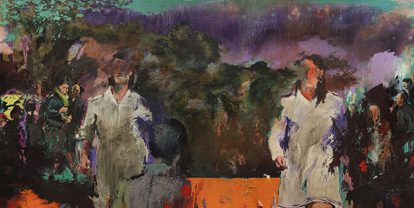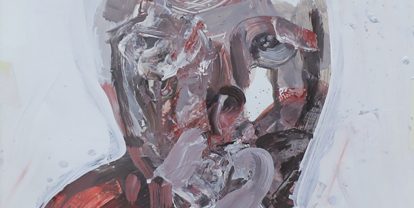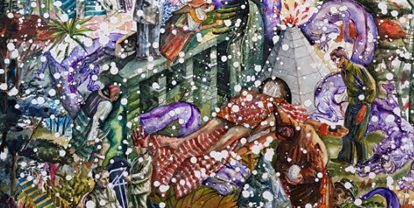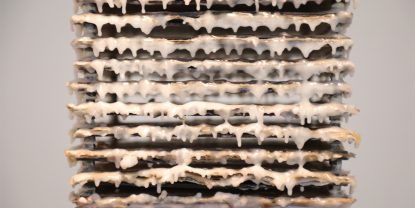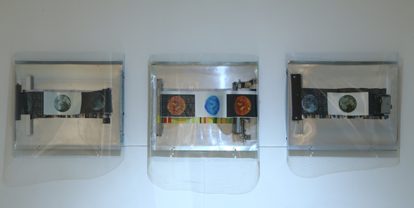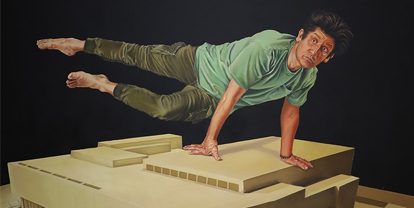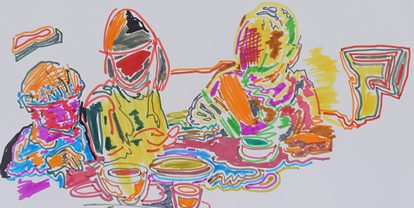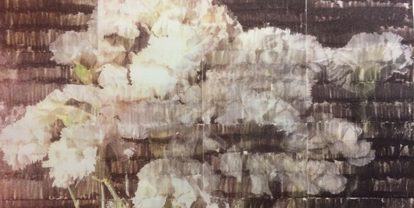Factory 02
Group Exhibition
July 05 — July 24, 2019
“Factory” is a series of a group exhibition that is held each summer, showcasing the works in progress or less-seen artworks of a selected number of Mohsen Gallery’s artists. The annual event creates a chance for the gallery’s audience as well as collectors, curators, critics, and scholars to see the works that were not exhibited in the gallery or those that were presented in art fairs, group shows, and international exhibitions. This is the second instalment of “Factory” exhibitions, featuring works by Sasan Abri, Majid Biglari, Arya Tabendehpoor, Amir-Hossein Zanjani, Behrang Samadzadegan, Seyed Mohamad Mosavat, and Amir Mobed, with their unique concerns, media, and approaches.
Sasan Abri uses his usual watercolor-like technique in his “Sundays” series, in which flowers tell the story of man’s mortality and the memories’ immortality. With its appealing, impressionistic flowers, “Sundays” is both photographic and painterly. The juxtaposition of dark backdrops and war/cold colors in the foreground implies the contrasts and impermanent features of life’s flow: each Sunday will come and go, yet another Sunday will arrive.
“Rigid” depicts perseverance, while it is about falling apart. Mojtaba Amini’s self-portrait is a static slice of the moment a figure resists falling on a fragile paper house that in on the verge of collapse. When the painterly game is over, the figure falls on the house that is as big as he is, tearing apart the house that used to be his homeland once.
By representing events that are now reduced to mere signs in his “Mourning” series, Majid Biglari seeks to depict the transitory nature of social and environmental conditions in a formalistic fashion. Biglari puts together bits and pieces from the past that no longer have first-hand narrativeness and intently—not for praise, commemoration, or glorification, but for creating meaning, giving a renewed identity, and remembrance. As time passes and events lose their intensity, the initial shock or glory of these objects fade away and they become “ordinary” and “mundane.”
“Day,” “Night,” and “Noise” are three machines recovered from drying, cutting, and photo-printing systems. These machines depict images received from Earth, Moon, and Sun in three different ways, with three functions and three different sounds. By eliminating the initial value of first-hand images and manipulating photographs that are already touched by their publishers, Arya Tabandehpoor highlights the triviality of the images, i.e., he does not seek to represent the worth of the images.
In his “Catwalk,” Amir-Hossein Zanjani presents a painterly narrative of power and authority with passionate brushstrokes concealed in a marching song. These figures are from both domineering and subjugated groups: their rebellious and tame spirits is depicted along with a will to overpower them. It seems as though these figures, that are sometimes outspoken and sometimes silence, rear their head from among multiple layers of color. They march harmoniously together, while they seem to be ashamed of their true nature.
In “Heading Utopia” Behrang Samadzadegan presents his interpretation of Iranian history through fantasizing about the documents of Iranian political history, setting out on an imaginary journey to utopian destination. He raises questions, struggles, destroys, and creates, not considering the determinism of watercolor to be in conflict with events, surrender, winnings and losings, and our bewilderments in history. Just like the intricate nature of watercolor, events intermingle in these paintings: events that are in fact interconnected as they repeat and reoccur time and again.
Through the interplay between the image, the imagination, and the object, and by the abstract intermixture of figures and juxtaposing order and chaos, Seyed Mohamad Mosavat creates straightforward depiction of communities of figures. With his unique, exciting choice of colors, these fantastic characters and their relationships become lively, passionate, and intimate.
The residents of a small community that Amir Mobed represent symbolically in his “Creation” installation are in fact angels with broken wings that are incarcerated in the prison of powerful demons, no longer remembering that they could fly once. This pale and fragile installation, which is like an assemblage, represents a critical approach to sociopolitical and environmental issues.
